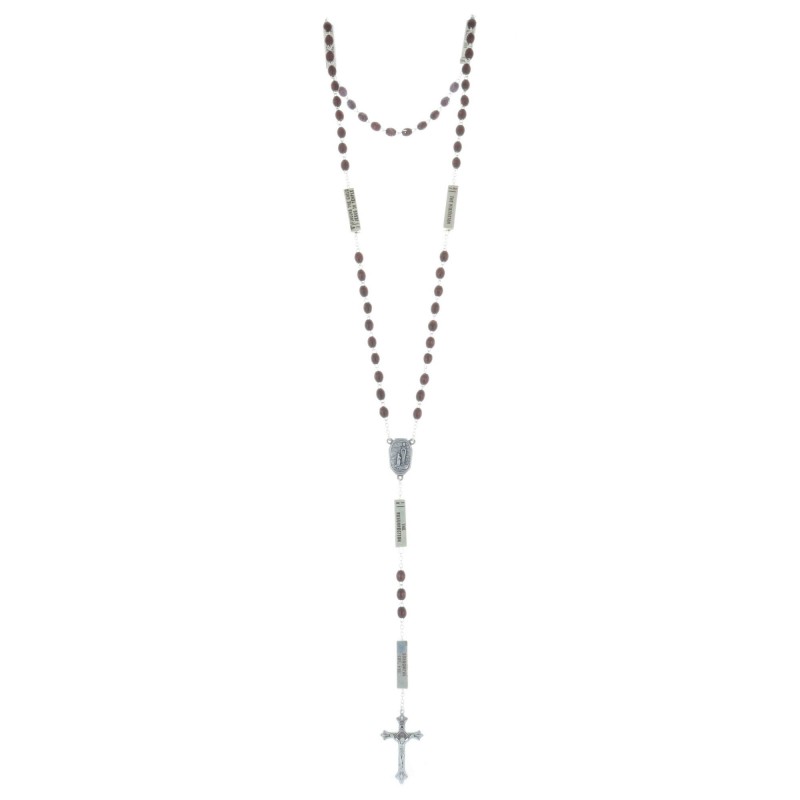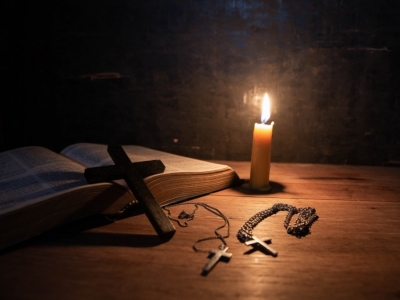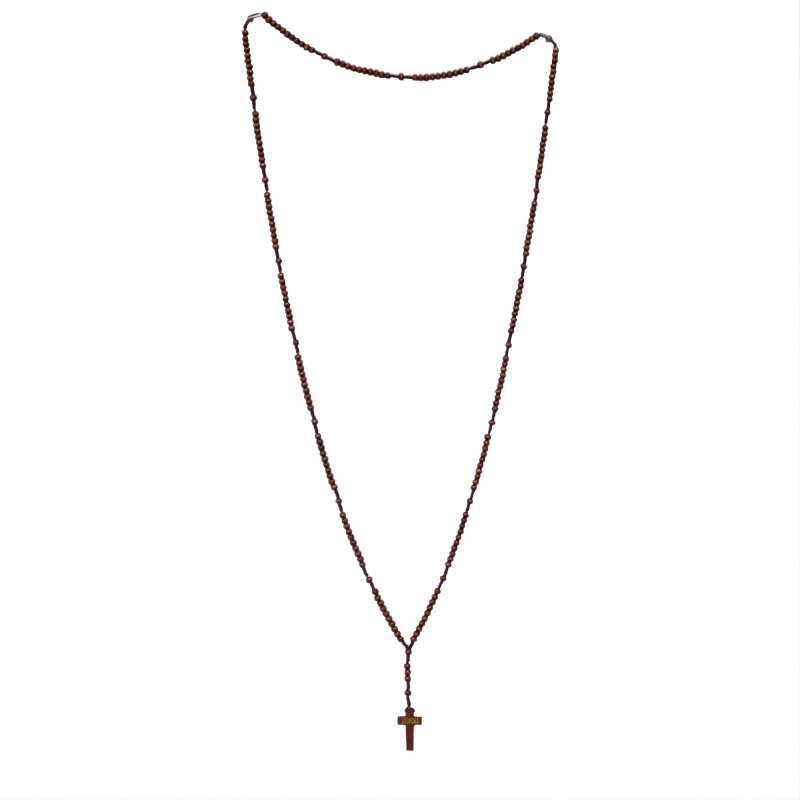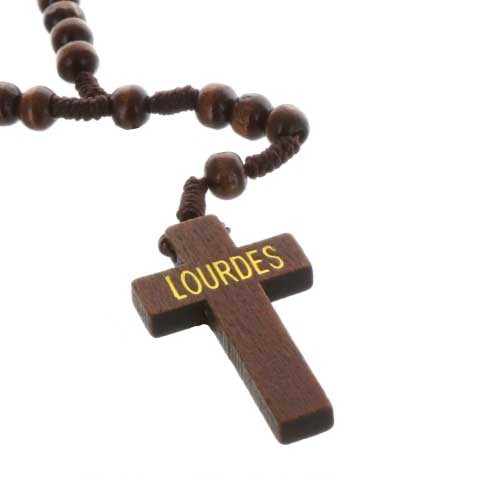Table of contents:
1- From antiquity to the present day, a sacred prayer that is constantly renewed
2- From the Patenôtre to the Rosary
3- Saint Dominic and the Rosary
4- The institution of the Rosary since the 13th century
5- The Joyful Mysteries of the Rosary
6- The Sorrowful Mysteries of the Rosary
7- The Glorious Mysteries of the Rosary
8- The Luminous Mysteries of the Rosary
The rosary is a very ancient prayer, dating back to the beginning of Christianity. Over the centuries and up to the pontificate of John Paul II, its practice has evolved several times. In the first centuries after Christ, it was a simple series of prayers counted with strings tied in 150 knots. Today, the Rosary is prayed with the four Mysteries, each mystery having its own assigned days and periods of the liturgical year.
The rosary is used to pray the rosary, the use of which dates back to the origins of Christianity. In this article we will look at the links between our Christian rosary and the rosary.
From antiquity to the present day, a sacred prayer that is constantly renewed.
From the Patenôtre to the Rosary
According to historians, praying with a rosary is very ancient. It is also found in many religions. In the beginning it was a rope knotted with 150 knots. Since monks from the fourth century onwards recited the 150 psalms of David, it was necessary to find a simple and easy prayer that illiterate believers could say.
The "Psalter of Christ" was therefore a sequence of 150 "Our Fathers" using the rosary of 150 knots or grains called a "patenôtre". In the 9th century, the "Psalter of the Virgin" appeared, which consisted of 150 "Hail Marys". With the crusades in the 11th century, the recitation of the rosary with this rudimentary rosary became widespread. Then from the revelations received by St Dominic in the 13th century the rite of the Rosary became more democratic.
St Dominic and the Rosary
Having withdrawn to a cave near Toulouse to pray about the heresies that were endangering the Church, St Dominic (1170-1221) was leading a life of fasting, prayer and devotion when the Virgin Mary appeared to him. After calming his torment, she revealed to him the Rosary as a remedy against the enemies of the Church: the more Christians prayed the Rosary, the more effective it would be. Thus, Our Lady presented the Rosary both as an object of meditation and individual salvation, but also as a means of preaching against heretics.
Our Lady suggested to St Dominic that the recitation of the Rosary be divided into three parts, echoing the moments in the life of Our Lady and of Christ who had passed through three stages: joy, suffering and glory.
The institution of the Rosary since the 13th century
From this time onwards, the rosary as we know it became widespread. At the same time, the Church spread the recitation of the Rosary, which is very long, during the week.
The Rosary as we know it is divided into two parts.
The first part consists of the sign of the cross to begin the prayer and the recitation of the Creed. The next four beads are: the large bead for an "Our Father" and the three smaller beads for three "Hail Marys".
In the transition from the first to the second part, a "Glory be to the Father" is recited. To begin each decade, the mystery on which the next decade of prayers will focus is announced, and then the "Our Father" is recited on the large beads and the "Hail Mary" on the small beads.
The joyful mysteries of the rosary
These mysteries represent the moments of joy experienced by the Virgin Mary and her son: like the five decades of the rosary, they are of the same number. The Joyful Mysteries are best prayed on Mondays and Saturdays and during the period from Advent to Priest Sunday.
The first mystery concerns the Annunciation: the moment when the angel Gabriel visited the Virgin Mary to announce to her that she would give birth to the Son of God. This is the mystery of humility.
The second mystery is dedicated to the Visitation: when Mary visited her cousin Elizabeth, the latter felt the child in her leap for joy. This prayer consecrates fraternal charity.
The third joyful mystery is that of the Nativity. Meditate on the coming of the Messiah among us.
The fourth joyful mystery concerns the presentation in the temple. An old man from Jerusalem named Simeon recognises Jesus as the Messiah. Here we pray about the quality of the presentation.
Finally, the fifth mystery concerns the recovery in the temple. Joseph and Mary were looking for Jesus in the city when, after three days, they found him in the temple sitting among the teachers of the law. This mystery is dedicated to obedience.
Each mystery can be followed by a meditation.
The Sorrowful Mysteries of the Rosary
These are dedicated to the Passion of Christ:
The Sorrowful Mysteries are recited especially on Tuesdays and Fridays and during the period from Priest's Sunday to the Resurrection.
The first mystery concerns the Agony of Jesus in the Garden: Jesus prays in Gethsemane, asking God to remove this painful moment. This is repentance.
The second mystery is dedicated to the Flagellation: Jesus does not resist his torturers, he abandons himself to pain: it is the mortification of the senses.
The third sorrowful mystery is that of the Coronation of Thorns: Jesus is crowned and hailed as a king, it is the moment of contempt for the mockery of the world.
The fourth sorrowful mystery is dedicated to the hour in which Jesus bears his cross, the hour of patience and submission.
Finally, the fifth mystery represents death on the cross, the moment of forgiveness of enemies.
The glorious mysteries of the rosary
The glorious mysteries represent the time of the resurrection and the events that followed it. They are mainly recited on Wednesdays and Sundays and from Resurrection Sunday to Pentecost Sunday.
The first mystery concerns the resurrection, the triumph over sin. The women go to the tomb of Christ and do not recognise him when he presents himself to them. It is an invitation to live as a new man or woman.
The second Glorious Mystery is dedicated to the Ascension: Jesus is taken up into heaven and sits at the right hand of the Father. This is the time to aspire for oneself and for others to the things mentioned above.
The third mystery is that of Pentecost: the Holy Spirit is poured out on all those present. For Christians it is an invitation to listen to and be led by the Spirit.
The fourth Glorious Mystery is the Assumption of Mary into Heaven. Christians can ask for the grace of a good death.
Finally, the fifth Glorious Mystery represents the crowning of the Virgin in Heaven: it is the time to entrust oneself to the Virgin, the time to pray to her.
The Luminous Mysteries of the Rosary.
These were added in 2002 by Pope John Paul II during the consecration of a Year of the Rosary from October 2002 to October 2003. This is the first change introduced in the meditation of the Rosary since the 13th century. So this pope is following in the footsteps of those who encouraged the prayer of the Rosary. The Luminous Mysteries help Christians to contemplate the public life of Jesus. They are mainly recited on Thursdays. This addition of a mystery changed the old order of prayer days.
The first Luminous Mystery concerns the Baptism in the Jordan, which celebrates sonship to the Father, but also the first step towards redemption, the state of grace.
The second Luminous Mystery is dedicated to the wedding feast of Cana: during the wedding feast of Cana, at Mary's request, Jesus transforms water into wine. It is the celebration of trust, of rebirth in the Holy Spirit.
The third luminous mystery is that of Jesus' preaching. Jesus announces the Kingdom among us, it is the moment of conversion and aspiration to the Kingdom.
The fourth luminous mystery is the Transfiguration. During a prayer with John, James and Peter, his disciples see him transfigured in the Glory of God. The fruit of the mystery is the grace of an interior life and the observance of Jesus' words.
Finally, the fifth luminous mystery is the institution of the Eucharist. Here we celebrate the participation and love of the Eucharist as it was transmitted to us by the Lord at the Last Supper.
The Rosary remains a prayer widely practised by Catholics throughout the world. It was revived and practised again after the Year of the Rosary initiated by John Paul II in 2002.
Prayer for the Rosary
Lord, we come to you to thank you for the prayer of the Rosary.
We thank you for the comfort and peace it brings to our hearts. We thank you for the blessings you have bestowed through this prayer.
We ask you to give us the grace to meditate on the mysteries of the life of your Son Jesus and his Mother Mary.
We ask you to help us to understand the teachings of your Gospel and to put them into practice in our daily lives.
We ask you to give us the strength to overcome the temptations and trials we face.
We ask you to bless the people who have brought the Rosary into our lives, and to protect them from all harm.
We thank you for all the blessings you have given us through the prayer of the Rosary and we entrust our life and soul to you.
Amen.






 The Mystery of the Five Wounds of Christ: A Profound Exploration of Their Spiri
The Mystery of the Five Wounds of Christ: A Profound Exploration of Their Spiri  Women's religious orders: A heritage of service and education
Women's religious orders: A heritage of service and education  What is Secours Catholique?
What is Secours Catholique?  Jesus' 40 Days in the Desert: A Spiritual Exploration
Jesus' 40 Days in the Desert: A Spiritual Exploration  In un mondo di connessioni costanti e distrazioni digitali, la Quaresima si sta
In un mondo di connessioni costanti e distrazioni digitali, la Quaresima si sta